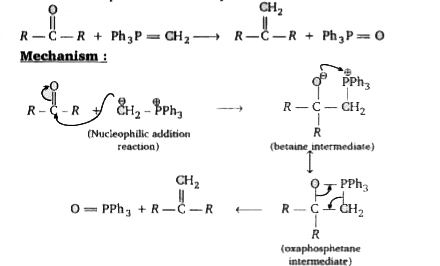The number of carbonyl carbon in the products X is
Propyne O3/CH2CL2,Δ−−−−−−−−−→Zn/H2OX
The correct Answer is:2
To solve the problem, we need to analyze the reaction of propyne with ozone followed by zinc hydrolysis to determine the number of carbonyl carbons in the product X.
1. Identify the Structure of Propyne:
Propyne is an alkyne with the formula C3H4. Its structure can be represented as:
CH3−C≡C
2. Ozonolysis Reaction:
When propyne undergoes ozonolysis, it reacts with ozone (O3) in a solvent like dichloromethane (CH2Cl2). The triple bond breaks, and an ozonide is formed. The ozonide structure can be represented as:
CH3−C(O)−C(O)−H
This structure contains a carbonyl (C=O) group.
3. Zinc Hydrolysis:
The ozonide is then treated with zinc in the presence of water (Zn/H2O). During this step, the ozonide will be hydrolyzed, resulting in the cleavage of the ozonide and the formation of carbonyl compounds. The reaction leads to:
CH3−C(O)−H+H2C=O
This results in two products: acetone and formaldehyde.
4. Counting Carbonyl Carbons:
In the final product X, we have:
- One carbonyl carbon from acetone (CH3−C(O)−CH3)
- One carbonyl carbon from formaldehyde (H2C=O)
Therefore, the total number of carbonyl carbons in product X is:
2
Final Answer:
The number of carbonyl carbons in the product X is 2.
---
Propyne is an alkyne with the formula C3H4. Its structure can be represented as:
CH3−C≡C
When propyne undergoes ozonolysis, it reacts with ozone (O3) in a solvent like dichloromethane (CH2Cl2). The triple bond breaks, and an ozonide is formed. The ozonide structure can be represented as:
CH3−C(O)−C(O)−H
This structure contains a carbonyl (C=O) group.
The ozonide is then treated with zinc in the presence of water (Zn/H2O). During this step, the ozonide will be hydrolyzed, resulting in the cleavage of the ozonide and the formation of carbonyl compounds. The reaction leads to:
CH3−C(O)−H+H2C=O
This results in two products: acetone and formaldehyde.
In the final product X, we have:
- One carbonyl carbon from acetone (CH3−C(O)−CH3)
- One carbonyl carbon from formaldehyde (H2C=O)
2
The number of carbonyl carbons in the product X is 2.
Similar Questions
Knowledge Check
Wittig reaction :
The reaction of a phosphorus ylide with an aldehyde (or) ketone introduces a carbon-carbon double bond is place of the carbonyl bond.

Driving froce of the reaction is high bond energy of (P = O). (ΔH=−ve).
CH3−O∣∣C−CH2−CH2−CH2−CH2−⊕PPh3Ph−Li−−−−→Δ(A), Major product (A) is :A B
B C
C D
D
In the following sequence of reactions, the alkene affords the compound 'B'
CH3CH−CHCH3O3−−→AH2O−−−−−→ZnB the compound B isACH3CH2CHOBCH3COCH3CCH3CH2COCH3DCH3CHOThe order of SN1 reactivity in aqueous acetic acid solution for the compounds
H3C−O∣∣C−CH2−Cl(1) H3C−CH2−CH2−Cl(2) (H3C)3C−Cl(3)A1>2>3B1>3>2C3>2>1D3>1>2
The number of alpha carbon-hydrogen atoms present in C2H5−CH3∣C⊕−H
View SolutionIn the given reaction sequences the final product 'C' is
CH3−CH2−OH(i)KMnO4/−OH/Δ−−−−−−−−−−−−−−−→(ii)H2O+(A)(i)SOCl2−−−−−−−−→(ii)NH3(B)Br2/KOH−−−−−−→(C)
View SolutionIn the given reaction the products is :
CH3−CH2−C∣∣O−OCH3+CH3−C∣∣O−OCH3(1)CH3OΘNa+−−−−−−−−−−→(2)CH3OHoversert(H2O)−−→Δ product
View Solution_2019_CBT2_E01_030_Q01.png)
(1)Cl2/hv−−−−−−→(2).HOΔ product is
View SolutionWhat will be the final product in the following reaction sequence? CH3CH2CNH+/H2O−−−−−→ANH3−−→ΔBNaOBr−−−→C
View Solution
